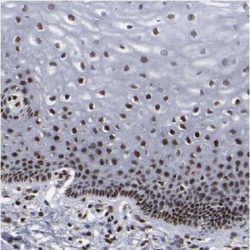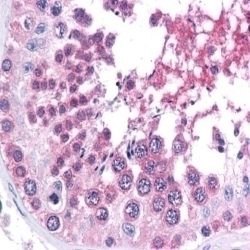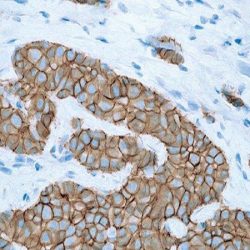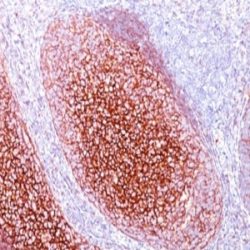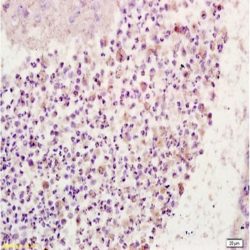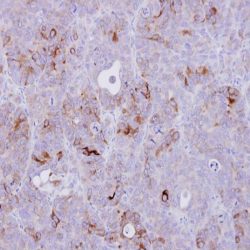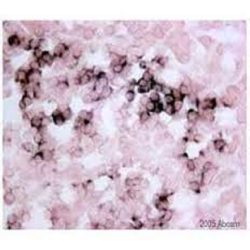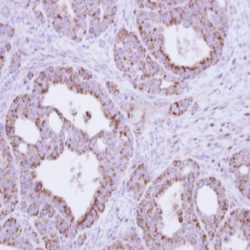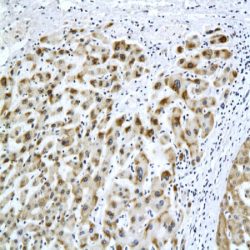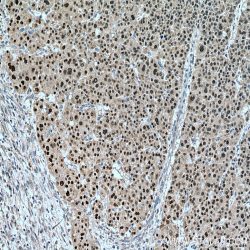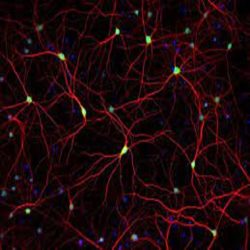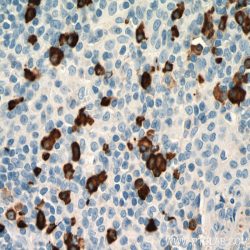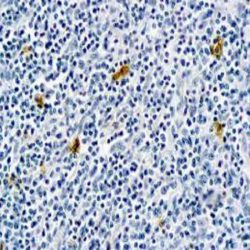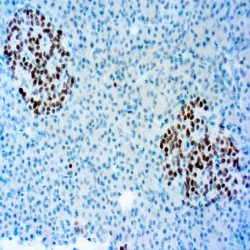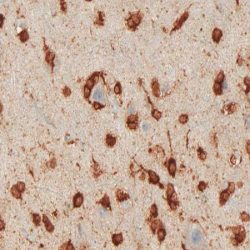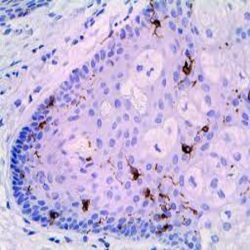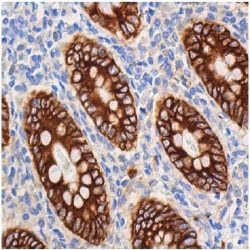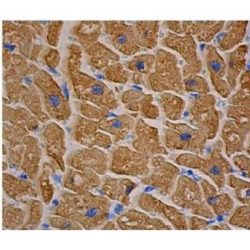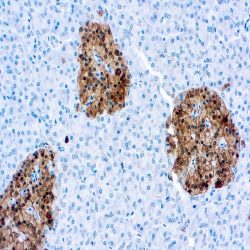ایمونو هیستوشیمی
نمایش 301–320 از 344 نتیجه
فیلتر ها-
آنتی بادیهای ایمونوهیستوشیمی
آنتی بادی ATRX (POLYCLONAL)
امتیاز 0 از 5اطلاعات بیشترName: ATRX (POLYCLONAL)
Description and aplications: ATRX, also known as ATP-dependent helicase ATRX, Xlinked helicase II,X-linked nuclear protein or Znf-HX, is encoded by a gene located in the chromosomal region Xq21.1, which undergoes an inactivation and encodes a nuclear and homologous NTP protein with several types of helicases II present at the membrane level. It belongs to the superfamily of proteins similar to the SNF2 subgroup and features a C-terminal region rich in glutamine similar to other nuclear transcription factors. Mutations of the gene cause a severe mental retardation syndrome linked to alphathalassemia (ATR-X syndrome) characterized by severe psychomotor retardation, characteristic facial features, urogenital abnormalities and alpha thalassemia with H hemoglobin inclusions at the erythrocyte level. Other syndromes related to mutations of the ATRX gene have been described such as X-linked mental retardation-hypotonic faciessyndrome or alpha thalassemia myelodysplastic syndrome. After interacting with the DAXX domain and potential binding with the EZH2, the ATRX protein plays several roles in mitosis, rearrangement of the chromatin and transcription as well as in the biology of the telomeric regions.
Composition: Rabbit anti-ATRX plyclonal antibody obtained from purified ascitic fluid and prepared in 10mM PBS, pH
7.4, with 0.2% BSA and 0.09% sodium azide.Immunogen: Recombinant protein corresponding to the alpha thalassemia X-linked intellectual disability syndrome (ATR-X) subunit.
-
آنتی بادیهای ایمونوهیستوشیمی
آنتی بادی BRG1 (EPNCIR111A)
امتیاز 0 از 5اطلاعات بیشترName: BRG1 (EPNCIR111A)
Description and aplications: BRG1, also known as SMARCA4 or BAF190A, SNF2B and SNF2L4, is a member of the enzymatic chromatin remodeling complex SWI/SNF, where it encodes the catalytic subunit that intervenes in the configuration of nucleosomes, making the transcriptional activation of the complex more accessible. The gene encoding the protein is located in the chromosome region 19p13.2, whose alterations have primarily been associated with the rhabdoid tumor predisposition syndrome-2 and Coffin-Siris syndrome 4. The former is characterized by a predisposition to develop renal or extrarenal rhabdoid tumors as well as a variety of brain tumors among which are choroid plexus carcinoma, meduloblastoma and PNET. CoffinSiris syndrome 4 presents both autosomal recessive and dominant transmission and is characterized by intellectual disability, psychomotor retardation, coarse facial features and multiple congenital malformations such as aplasia or hypoplasia of thedistal phalanx or fifth finger nail. Additionally, cardiac, gastrointestinal, genitourinary or central nervous system malformations may be associated.
Composition: Anti-human BRG1 rabbit monoclonal antibody purified from serum and prepared in 10mM PBS, pH 7.4, with 0.2% BSA and 0.09% sodium azide
Immunogen: Synthetic peptide corresponding to the fraction of amino acids 200-300 of the mouse BRG1.
-
آنتی بادیهای ایمونوهیستوشیمی
آنتی بادی Cadherin E (HECD-1)
امتیاز 0 از 5اطلاعات بیشترName: Cadherin E (HECD-1)
Description and aplications: E-cadherin is a transmembrane glycoprotein that mediates epithelial cell-to-cell adhesion. The loss of Ecadherin can result in the disruption of cell clusters. It is therefore, postulated that E-cadherin may function as a tumor suppressor protein. The loss of E-cadherin has been associtated with metastasis and poor prognosis in invasive breast cancer and can help differentiate between ductal and lobular neoplasms of the breast. It has also been shown to be an independent predictor in the disease progression in bladder cancer.
Composition: Anti-human Cadherin E mouse monoclonal antibody purified from serum and prepared in 10mM PBS, pH
7.4, with 0.2% BSA and 0.09% sodium azide -
آنتی بادیهای ایمونوهیستوشیمی
آنتی بادی CD35 (EP197)
امتیاز 0 از 5اطلاعات بیشترName: Rabbit anti-human CD35 Monoclonal Antibody (Clone EP197)
Description and aplications: Anti-CD35, also named as erythrocyte complement receptor 1 (CR1), is a member of the complement activation (RCA) family and is located in the ‘cluster RCA’ region of chromosome 1. CD35 is considered a mature B-cell marker which labels follicular dendritic reticulum cells and tumors derived from, such as follicular dendritic cell tumor/sarcoma. CD35 antigen is found on erythrocytes, B cells, a subset of T cells, monocytes, as well as eosinophils, and neutrophils. This antibody labels also the dendritic cells in tonsil and spleen and glomerular podocytes in kidney.
Composition: Anti-human CD35 rabbit monoclonal antibody purified from serum and prepared in 10mM PBS, pH 7.4, with 0.2% BSA and 0.09% sodium azide
Immunogen: A synthetic peptide corresponding to residues of human CD35 protein.
-
آنتی بادیهای ایمونوهیستوشیمی
آنتی بادی CD64 (EPR4624)
امتیاز 0 از 5اطلاعات بیشترName: Rabbit anti-human FCGR1A (CD64) Monoclonal Antibody (Clone EPR4624)
Description and aplications:This antibody, also known as HAM56, recognizes the immunoglobulin gamma receptor 1 (FcγRI/CD64) expressed in healthy people in approximately 10% of the circulating monocytes and encoded by a gene
located in the chromosome region 1q21.2. There are three types of FcγRs expressed in circulating monocytes, the high-affinity FcγRs/CD64 receptor, being expressed constitutively; the low-affinity FcγRII/CD32 with two isoforms functionally different and the moderate-affinity receptor FcγRIII/CD16, expressed in 10%-15% of circulating monocytes. This antibody can be used for the detection of some leukemias with monocytic differentiation such as the acute myeloid leukemia (AML) without maturation
Composition:Anti-human FCGR1A (CD64) rabbit monoclonal antibody purified from serum and prepared in 10mM PBS, pH 7.4, with 0.2% BSA and 0.09% sodium azide.
Immunogen: Synthetic peptide corresponding to the C-terminus of the human FCGRA1
-
آنتی بادیهای ایمونوهیستوشیمی
آنتی بادی CD74 (LN-2)
امتیاز 0 از 5اطلاعات بیشترName: Mouse anti-human CD74 Monoclonal Antibody (Clone LN2)
Description and aplications: This antibody reacts with a 35-kD antigen related to the HLA complex invariant chain. The antigen is expressed in mantle and germinal centre B cells. It is also expressed in monocytes, macrophages,
interdigitating reticular cells, endothelium, and some other epithelia. This antibody may be used for the identification of B lymphomas (except for plasmacytomas). It also reacts with some T lymphomas containing activated neoplastic cells and Reed-Sternberg cells.
Composition: Anti-human CD74 mouse monoclonal antibody purified from serum and prepared in 10mM PBS, pH 7.4, with 0.2% BSA and 0.09% sodium azide.
Immunogen: Lymphoma cell line SU-DHL-4.
-
آنتی بادیهای ایمونوهیستوشیمی
آنتی بادی Digoxigenin (HY-A.1)
امتیاز 0 از 5اطلاعات بیشترName: Mouse anti-human Digoxigenin Monoclonal Antibody (Clone HY-A.1)
Description and aplications: This product is recommended for the qualitative detection of DNA probes marked with digoxigenin, on formalin-fixed paraffin-embedded tissue sections.
Composition: Anti-human Digoxigenin mouse monoclonal antibody purified from serum and prepared in 10mM PBS, pH 7.4, with 0.2% BSA and 0.09% sodium azide
-
آنتی بادیهای ایمونوهیستوشیمی
آنتی بادی Epithelial Specific Antigen (MOC-31)
امتیاز 0 از 5اطلاعات بیشترName: Mouse anti-human Ep-CAM/Epithelial Specific Antigen Monoclonal Antibody (Clone MOC-31)
Description and aplications: This antibody reacts with the 40 kDa transmembrane protein, which is present in most of normal and tumor epithelia. This antibody shows a wide pattern of reactivity with human epithelial tissues: simple epithelia, pseudostratified epithelia and transitional epithelia, but not with mature squamous epithelium. In paraffin-embedded formalin-fixed tissue sections, staining for MOC-31 is observed in the kidney epithelium, endometrial cells, mammary acini, hepatic biliary ducts, prostatic glandular epithelium, acini, ducts and pancreatic islets of Langerhans.
Composition: Anti-human Ep-CAM mouse monoclonal antibody purified from serum and prepared in 10mM PBS, pH 7.4, with 0.2% BSA and 0.09% sodium azide
Immunogen: Neuraminidase treated cells from a variant small cell lung carcinoma cell line (GLS-1).
-
آنتی بادیهای ایمونوهیستوشیمی
آنتی بادی Fumarate Hydratase (J-13)
امتیاز 0 از 5اطلاعات بیشترName: Mouse anti-human Fumarate Hydratase Antibody (Clon J-13)
Description and aplications: The fumarate hydratase protein (FH) is an enzyme of the Krebs cycle that catalyzes the reversible and sterospecific transformation of the fumarate to Fmalate.There exist two isoforms, the FH1 located a cytosolic level, where is responsible for the hydratio from the fumarate to L-malate, and the mitochondrial FH2, responsible for the dehydration from the Lmalate to fumarate. The secretion of the enzyme is coded by a gene located in the chromosome region 1q43. The lack of this gene determines severe metabolic disorders characterized by early hypotonia, psychomotor retardation and brain anomalies such as agenesis of the corpus callosus, anomalies in the gyri and ventriculomegaly.
Composition: Composition: anti-human Fumarate Hydratase mouse monoclonal antibody purified from serum and prepared in 10mM PBS, pH 7.4, with 0.2% BSA and 0.09% sodium azide
-
آنتی بادیهای ایمونوهیستوشیمی
آنتی بادی HBc Antigen (CORE) (Polyclonal)
امتیاز 0 از 5اطلاعات بیشترName: Rabbit anti-human Hepatitis B Virus Core Antigen (HBVcAg) Polyclonal Antibody
Description and aplications: Hepatitis B virus is spherical in shape with a diameter of 42 nm. It contains a 27 nm partially double stranded DNA core enclosed within a lipoprotein coat. The antigenic activity of the nucleocapsid core is designated as hepatitis B core antigen. The antigens in the outer surface are called as hepatitis B virus surface antigens.
Core antigens are localized within the nuclei whereas the surface antigens are present in the cytoplasm of the infected cells. Antibodies to surface antigens appear in circulation at an early stage of infection whereas the antibodies to the core antigens are detected after several weeks. This antibody recognizes a protein in the core of hepatitis B virus.Composition: Anti-human HBVcAg rabbit polyclonal antibody purified from serum and prepared in 10mM PBS, pH
7.4, with 0.2% BSA and 0.09% sodium azide
Immunogen: Hepatitis B virus.
-
آنتی بادیهای ایمونوهیستوشیمی
آنتی بادی HNF-1 beta (Hepatocyte Nuclear Factor 1 betaHomeobox A) (Polyclonal)
امتیاز 0 از 5اطلاعات بیشترName:HNF-1 beta (Hepatocyte Nuclear Factor 1 beta Homeobox A) (Polyclonal)
Description and aplications: Hepatocyte nuclear factors, a group of phylogenetically unrelated transcription factors
belonging to the group of hemoproteins, is made up of the molecules HNF-1 with its isoforms and , HNF-3 (, and ), HNF-4 (, and ) and HNF-6 which regulate the transcription of a wide group of genes and proteins which include among others clotting factors, and enzymes and transporters related to metabolism and glucose, cholesterol and fatty acids transport.Composition: Anti-human HNF-1 beta rabbit polyclonal antibody purified from serum and prepared in 10mM PBS, pH
7.4, with 0.2% BSA and 0.09% sodium azide
Immunogen: synthetic protein corresponding to the specific sequence of amino acids -
آنتی بادیهای ایمونوهیستوشیمی
آنتی بادی HuC/HuD Neuronal Protein (16A11)
امتیاز 0 از 5اطلاعات بیشترName: Mouse anti-human HuC/HuD Neuronal Protein Monoclonal Antibody (Clone 16A11)
Description and aplications: The Hu antigen is a protein of the Elav (embryonic lethal abnormal visual) family. This antibody recognises only some protein members of the Elav family (HuC, HuD, and Hel-N1), all of them neuronal proteins. It does not recognise HuR, another Elav family member that is present in all proliferating cells. This antibody can be considered as a neuron marker. This antibody identifies neuronal cells and neoplasms derived from them.
Composition:Anti-human HuC/HuD Neuronal Protein mouse monoclonal antibody purified from serum and prepared in 10mM PBS, pH 7.4, with 0.2% BSA and 0.09% sodium azide
-
آنتی بادیهای ایمونوهیستوشیمی
آنتی بادی Human IgA (Polyclonal)
امتیاز 0 از 5اطلاعات بیشترName: Rabbit anti-human IgA Antibody (Polyclonal)
Description and aplications:Anti-IgA antibody reacts with surface immunoglobulin IgA alpha chains. It is useful when identifying leukemias, plasmacytomas, and B-cell lineage derived Hodgkin’s lymphomas. Due to the restricted expression of heavy and light chains in these diseases, demonstration of Bcell lymphoma/plasmacytoma is aided with this antibody.
Composition: Anti-human IgA rabbit polyclonal antibody purified from serum and prepared in 10mM PBS, pH 7.4, with
0.2% BSA and 0.09% sodium azide
-
آنتی بادیهای ایمونوهیستوشیمی
آنتی بادی Human IgE (Polyclonal)
امتیاز 0 از 5اطلاعات بیشترName: Rabbit anti-human IgE Antibody (Polyclonal)
Description and aplications: This antibody recognises the human immunoglobulin epsilon heavy chain. The common feature of both plasmacytomas and certain types of non-Hodgkin lymphoma is the expression of a single class of heavy chain. The demonstration of clonality in lymphoproliferative processes indicates that the process is clonal and therefore malignant. This antibody is useful for the identification of leukaemias, plasmacytomas and some types of non-Hodgkin lymphoma. It does not cross-react with the heavy chains of immunoglobulins IgA, IgG, IgM and IgD, nor with T cells, monocytes, granulocytes or erythrocytes.
Composition:anti-human IgE rabbit polyclonal antibody purified from serum and prepared in 10mM PBS, pH 7.4, with 0.2% BSA and 0.09% sodium azide
Immunogen: IgE isolated from normal human serum.
-
آنتی بادیهای ایمونوهیستوشیمی
آنتی بادی INSM1 (A-8)
امتیاز 0 از 5اطلاعات بیشترName: Mouse anti-human INSM1 (Insulinoma-associated protein 1) Monoclonal Antibody (Clone A-8)
Description and aplications: INSM1 protein, also known as IA1, is a nuclear transcription factor encoded by INSM1 gene, located in the chromosome region 20p11.23 and composed of 510 amino acids with a molecular mass of approximately 52.8kDa. The protein, which shows a wide homology in different species, contains a Cterminal portion with 5 finger-binding domains and an N-terminal domain with four pro-hormone conversion sites as well as an amidation signal sequence. INSM1 factor plays an important role in neurogenesis and differentiation during the embryonic and fetal development of the pancreatic neuroendocrine, anterior pituitary, intestine cells and synapto-adrenal cells of the peripheral nervous system. INSM1 gene, which does not express in normal endocrine and non-endocrine tissues in adults, acts as a suppressor gene of the transmission pathways NEUROD1 and INS after interaction with Cyclin D1, inhibits the specific genes of the skeletal muscle in neuroendocrine cells of the pituitary and suppress neural factors such as HDAC1, HDAC2, HDAC3 and KDM1A (involved in the incorporation of chromatin-modifying factors). In addition to this, it suppresses the activity of the histone deacetylase RCOR1.
Composition: Anti-human INSM1 mouse monoclonal antibody purified from serum and prepared in 10mM PBS, pH
7.4, with 0.2% BSA and 0.09% sodium azide -
آنتی بادیهای ایمونوهیستوشیمی
آنتی بادی Isocitrate Dehydrogenase 1 R132H point mutated form (IDH1 R132H) (H09)
امتیاز 0 از 5اطلاعات بیشترName: Mouse Anti-Human Isocitrate Dehydrogenase 1 R132H point mutated form (IDH1 R132H) (H09)
Description and aplications: Antibody clone H09 reacts specifically with the isocitrate dehydrogenase 1 (IDH1) R132H point mutated form in tissue sections from formalin-fixed brain tumor specimens. Heterozygous point mutations of IDH1 codon 132 are frequent in World Health Organization (WHO) grade II and III gliomas. IDH1 R132H mutations occur in approximately 70% of astrocytomas and oligodendroglial tumors. The high frequency and distribution of the IDH1 R132H mutation among specific brain tumor entities allow the highly sensitive and specific discrimination of various tumors by
immunohistochemistry, such as anaplastic astrocytoma from primary glioblastoma or diffuse astrocytoma WHO grade II from pilocytic astrocytoma or ependymoma. Noteworthy is the discrimination of the infiltrating edge of tumors with IDH1 mutation from reactive gliosis. This antibody is highly useful for tumor classification and in detecting single infiltrating tumor cells.
Composition:anti-Isocitrate Dehydrogenase 1 R132H (IDH1 R132H) mouse monoclonal antibody obtained from supernatant culture and prediluted in a tris buffered solution pH 7.4 containing 0.375mM sodium azide solution as bacteriostatic and bactericidal. The quantity of the active antibody was not determined.
Immunogen: Synthetic peptide, amino acid sequence CKPIIIGHHAYGD
-
آنتی بادیهای ایمونوهیستوشیمی
آنتی بادی Langerin/CD207 (EPR15863)
امتیاز 0 از 5اطلاعات بیشترName: Rabbit anti-human Langerin/CD207 Monoclonal Antibody (Clone EPR15863)
Description and aplications: Calciumdependent lectin displaying mannose-binding specificity. Induces the formation of Birbeck granules (BGs); is a potent regulator of membrane superimposition and zippering. Binds to sulfated as well as mannosylated glycans, keratan sulfate (KS) and beta-glucans. Facilitates uptake of antigens and is involved in the routing and/or processing of antigen for presentation to T cells. Major receptor on primary Langerhans cells for Candida species, Saccharomyces species, and Malassezia furfur. Protects against human immunodeficiency virus-1 (HIV-1) infection. Binds to high-mannose structures present on the envelope glycoprotein which is followed by subsequent targeting of the virus to the Birbeck granules leading to its rapid degradation.
Composition: Anti-human Langerin/CD207 rabbit monoclonal antibody purified from serum and prepared in 10mM
PBS, pH 7.4, with 0.2% BSA and 0.09% sodium azide
Immunogen: Recombinant fragment within Human Langerin aa 200 to the C-terminus.
-
آنتی بادیهای ایمونوهیستوشیمی
آنتی بادی Mucin 4 (8G7)
امتیاز 0 از 5اطلاعات بیشترName: Mouse anti-human Mucin 4 (MUC4) Monoclonal Antibody (Clone 8G7)
Description and aplications: Mucins are a group of high molecular weight glycoproteins consisting of a mucin core protein and O-linked carbohydrates. Mucin 4, a membrane-bound mucin, is the human homolog of the rat sialomucin complex (SMC). Mucin 4 protein consists of Mucin 4α, a large amino mucin type subunit and Mucin 4β, a transmembrane subunit containing three EGF-like domains. The Mucin 4 gene is the predominant mucin gene expressed in the normal urothelium and is also expressed in several normal tissues such as trachea, lung and testis.
Composition: Anti-human MUC4 mouse monoclonal antibody purified from serum and prepared in 10mM PBS, pH
7.4, with 0.2% BSA and 0.09% sodium azide
Immunogen: A synthetic peptide directed against the Mucin 4 tandem repeats of human origin.
-
آنتی بادیهای ایمونوهیستوشیمی
آنتی بادی Myosin – Skeletal Muscle (MY-32)
امتیاز 0 از 5اطلاعات بیشترName: Mouse anti-human Myosin – Skeletal Muscle Monoclonal Antibody (Clone MY-32)
Description and aplications: This antibody reacts against the skeletal muscle myosin heavy chain. Myosin is a 480-kDa protein present in muscle and non-muscle cells. This antibody may be used as a tool for the diagnosis of tumours of skeletal muscle origin. It may also be useful in studies of the architecture of thick filament cytoskeleton. It does not react with human or animal cardiac myosin or smooth muscle myosin. It reacts with myosin of human, rabbit, rat, murine, bovine, and guinea pig origin.
Composition: Anti-human Myosin – Skeletal Muscle mouse monoclonal antibody purified from serum and prepared in 10mM PBS, pH 7.4, with 0.2% BSA and 0.09% sodium azide
Immunogen: Rabbit myosin.
-
آنتی بادیهای ایمونوهیستوشیمی
آنتی بادی Neuron Specific Enolase (NSE) (Polyclonal)
امتیاز 0 از 5اطلاعات بیشترName: Rabbit anti-human Neuron Specific Enolase (NSE) Polyclonal Antibody
Description and aplications: Enolase is a glycolytic enzyme catalyzing the reaction pathway between 2-phospho glycerate and phosphoenol pyruvate. In mammals, enolase molecules are dimmers composed of three distinct subunits (α,β and γ). The alpha-subunit is expressed in most tissues and the beta-subunit only in muscle. The gamma-subunit is expressed primarily in neurons, in normal and in neoplastic neuroendocrine cells. Co-expression of NSE and chromogranin A is common in neuroendocrine neoplasms.
Composition: Anti-human NSE rabbit polyclonal antibody purified from serum and prepared in 10mM PBS, pH 7.4, with
0.2% BSA and 0.09% sodium azide
Immunogen: Synthetic peptide derived from Cterminus of human NSE.

